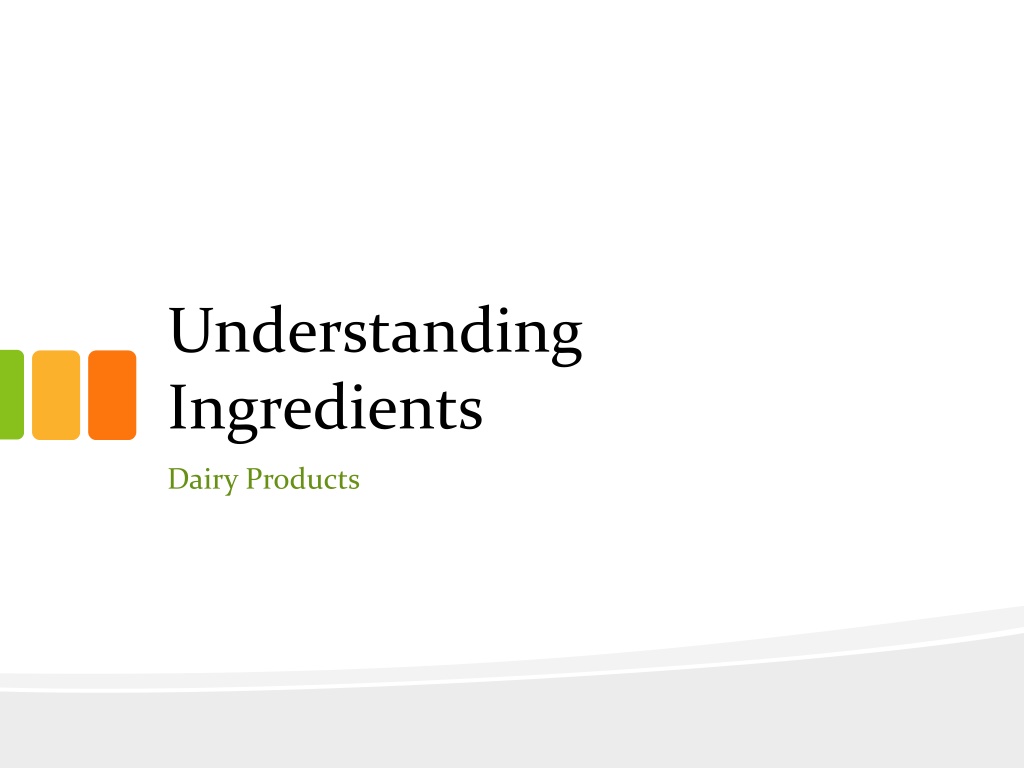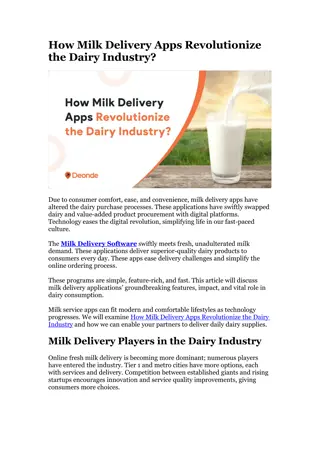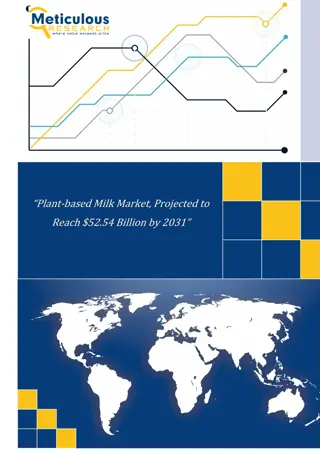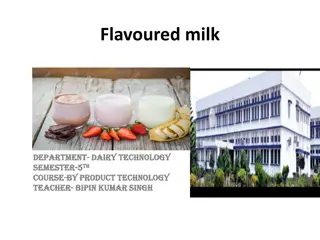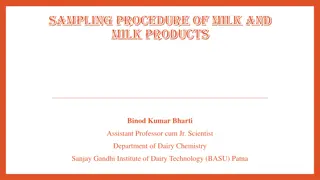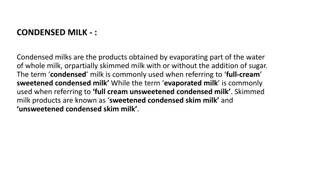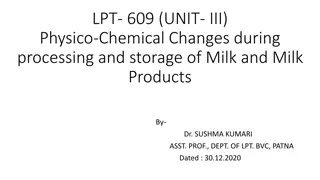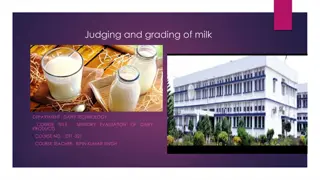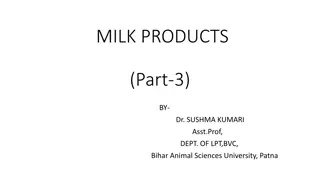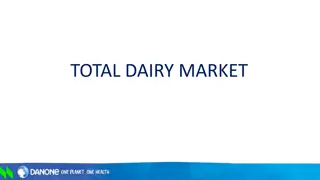Exploring Dairy Products and Milk Varieties
The article delves into the realm of dairy products, focusing on various types such as milk, cheese, yogurt, cream, and butter. It explains how milk, produced by mammals like cows and sheep, serves as a vital source of nutrition for infants. Additionally, it details different heat treatments applied to milk, creating products like homogenized milk. The content also discusses non-dairy alternatives and non-bovine milk options.
Download Presentation

Please find below an Image/Link to download the presentation.
The content on the website is provided AS IS for your information and personal use only. It may not be sold, licensed, or shared on other websites without obtaining consent from the author. Download presentation by click this link. If you encounter any issues during the download, it is possible that the publisher has removed the file from their server.
E N D
Presentation Transcript
Understanding Ingredients Dairy Products
Topics Introduction Types of Dairy Products Milk Cheese Yoghurt Cream Butter 2
Introduction Milk is produced by mammals such as cows, sheep, goats Babies of most species rely on milk for many months before they eat other food Milk contains total nutrition for the growth and development of babies, therefore babies do not need to eat other food Milk can also be made into many kinds of food, in general, they are called dairy products 4
Types of Dairy Products There are many products made from milk, the most commonly used dairy products include: Milk Cheese Yoghurt Cream Butter 6
Types of Dairy Products Non-dairy More economical than real dairy products because it does not contain the costly butterfat It consists of a vegetablefat or oil and nonfat milk solids The vegetable fat has traditionally been coconut oil, but it may be partially hydrogenated corn, cottonseed, palm, or soy oil Does not contain cholesterol Non-Bovine Milk Includes milk from goats (Mediterranean countries), sheep (southern Europe), and reindeer (northern Europe) 7
The following chart shows that raw milk can be manufactured into different dairy products: Skimmed milk Whey Yoghurt Cheese Drinking milk Cream Casein Raw milk Concen- trated milk Evaporated milk Butter Milk powder Condensed milk Buttermilk 8
Milk 9
Types of Milk Types of milk based on different heat treatment: Homogenised milk Homogenisation is to prevent creaming, or the rising of fat It is applied to whole milk or low-fat milk Milk is heated to 55-65oC at a high pressure of 200 atmospheres Fat globules reduced in size; no visible cream separation occurs Increases whiteness of milk; less susceptible to oxidised flavour 10
Types of Milk Types of milk based on different heat treatment (cont d): Pasteurised milk Pasteurisation kill bacteria and inactivate enzymes Low Temp Long Time (LTLT) 63oC for > 30 mins High Temp Short Time (HTST) 75oC for >15 sec Listeria and Coxiella species may survive at 72oC Cooled to 4 C immediately after heating 11
Types of Milk Types of milk based on different heat treatment (cont d): Sterilised milk In-bottle sterilisation Milk is filled into bottles, then heated at 104-110oC for 30-40 min or 110-120oC for 15-20 min 12
Types of Milk Types of milk based on different heat treatment (cont d): Ultra-Heat Treatment (UHT) Milk is rapidly heated to 135-150oC for at least 1 sec and then quickly cooled All microorganisms are destroyed Milk may be safely stored up to 3 months or longer 13
Types of Milk Types of milk based on modification of components: Whole milk Milk fat is standardised to 3.25 - 3.7% from raw milk of 3.25 5% Full flavour and smooth texture Low fat milk Milk fat is standardised to 1.5 1.8% Skimmed milk Milk fat is standardised to < 0.5% High-calcium milk It contains a higher level of calcium than regular milk 14
Types of Milk Legislative requirement on composition of milk and milk products Milk and milk products Legal requirement on fat percentage Milk and reconstituted milk Not less than 3.25% of milk fat Milk beverage Not less than 0.1% of milk fat Skimmed milk Not more than 0.3% of milk fat Semi-skimmed milk Not less than 1.5% and not more than 1.8% of milk fat Sweetened condensed or evaporated milk Not less than 8% of milk fat Unsweetened condensed or evaporated milk Not less than 7.8% of milk fat 15
Types of Milk Legislative requirement on composition of milk and milk products Milk and milk products Legal requirement on fat percentage Dried full cream milk Not less than 26% Dried partly skimmed milk Less than 26 and not less than 1.5% Dried skimmed milk Less than 1.5% 16
Types of Milk Types of milk based on modification of components (cont d): Evaporated milk Unsweetened concentrated milk Milk is concentrated through the process of evaporation in a vacuum chamber at 50 55 oC Volume is reduced to 60% Canning and sterilisation are performed The high temperature used in processing evaporated milk may produce a light tan colour due to Maillard reactions between the milk protein and the milk sugar, lactose 17
Types of Milk Types of milk based on modification of components (cont d): Condensed milk Sweetened concentrated milk Milk is concentrated with approximately 60% of the water removed and sugar levels of 40 45% in the finished product Sugar is added prior to evaporation Sweetened condensed milk is pasteurised, but not sterilised, because the high sugar content plays a role in preventing bacterial growth 18
Types of Milk Types of milk based on modification of components (cont d): Dried milk Dried milk powder may be processed from either pasteurised whole milk or skimmed milk Nowadays, dried milk is usually made by spray drying Milk is first condensed by removing two-thirds of the water and is typically sprayed into a heated vacuum chamber (spray drying) to dry to less than 5% moisture levels The drying process has no appreciable effect on the nutritive value of milk Most skimmed dried milk is fortified with vitamins A and D 19
Types of Milk Types of milk based on modification of components (cont d): Flavoured milk Made with addition of sugar, colourings and artificial or natural flavourings E.g. chocolate milk, coffee milk, strawberry milk, and papaya milk 20
Structures of Milk Milk is a dispersion of milk fat globules (fat particles) and casein micelles (protein particles) in a continuous phase of water, sugar (lactose), whey proteins, and minerals Milk Plasma is left after separating the fat globules; equivalent to skim milk for practical purposes Milk Serum is left after removing both fat globules and casein micelles; equivalent to cheese whey for most practical purposes Coagulation is what happens when the casein micelles stick together Because casein particles are hydrophobic (they hate water) their natural tendency is to aggregate (clump together) 21
Structures of Milk Milk serum (whey) Milk plasma (skimmed milk) Milk Casein micelles Fat globules To make cheese To make cream 22
Structures of Milk Milk is made of aqueous and oil Aqueous Oil/Fat Water Lactose Protein Casein Whey Vitamins Minerals Fat globules Fat soluble vitamins Selected proteins Enzymes (lipases) 23
Nutritive Value of Milk Proteins Milk contains high biological proteins casein and whey 8-ounce (~ 236 ml) serving of fluid milk contains 8 g of protein 24
Nutritive Value of Milk Fats The total lipid content of cow milk is in the range of 3 5% but the content depends on a wide variety of factors, including, breed, diet and health of the animal Fat percentage in drinking milk is altered by a process called standardisation Type of Milk Fat Percentage Raw 3.25 5% Whole 3.25 3.7% Low fat 1.5 2% Skimmed < 0.5% 25
Nutritive Value of Milk Carbohydrates Almost 5% of milk is carbohydrates Most carbohydrate in milk is sugar, in the form of lactose Lactose provides almost half of the calories of milk and gives milk its sweet flavour Lactose is a disaccharide made of two simple sugars, glucose and galactose An enzyme produced in the gut called lactase breaks the disaccharide producing glucose and galactose for the body to absorb and use A deficiency of lactase results in lactose intolerance People who are lactose-intolerant are unable to fully digest the sugar (lactose) in milk, and symptoms may include diarrhoea, gas and bloating after eating or drinking dairy products 26
Nutritive Value of Milk Minerals Calcium is one of the major minerals in milk and dairy products In cow s milk, its concentration is about 1200 mg/L Milk and dairy products are considered as one of the best sources of calcium Phosphorous and magnesium are important elements in milk and dairy products The major part of the calcium (99%) and phosphorous (85%) in the human organism is located in the bone tissues Drinking milk is advocated to prevent osteoporosis 27
Nutritive Value of Milk Vitamins Milk is an essential source of some vitamins such as vitamin A, vitamin B2 and vitamin B12 Some milk and dairy products are fortified with vitamins A and D Milk also contains the amino acid tryptophan, a precursor to niacin (vitamin B3) Water Almost 90% of milk is water 28
Choice and Storage of Milk Choosing milk Check the date label when buying Check that the package is intact For bottled milk , check that there are no clotted pieces For canned milk , check that cans are not dented or bulged 29
Choice and Storage of Milk Storing milk Store fresh milk in the refrigerator. Consume before the expiry date Keep unopened cartons of UHT milk, cans of evaporated and condensed milk in a cool dry place Once the container of milk is opened, the milk should be kept in the refrigerator away from strong-smelling foods Cover dried milk powder tightly to avoid formation of lumps due to humidity 30
Uses of Milk in Cooking / Diet Milk can be used in many different ways, e.g.: Drinks milk shakes, hot chocolate, caf latte Desserts steamed egg custard, panna cotta, ice cream, egg tart Savoury sauces white sauce, alfredo sauce Sweet sauces chocolate sauce, caramel sauce Batter pancakes, fritters Soups cream of mushroom soup, clam chowder Bakery products cakes, biscuits, breads Breakfast cereals Milk products such as cheese, yoghurt, cream, butter 31
Food and Nutrition Labelling of Milk Labelling of milk is controlled in Hong Kong legislation: List of ingredients Pre-packaged food shall be legibly marked or labelled with a list of ingredients List of allergenic substance Milk and milk products (including lactose) is an allergenic substance, the name shall be specified in the list of ingredients Appropriate durability indication Indication of best before or use by date 32
Food and Nutrition Labelling of Milk Labelling of milk is controlled in Hong Kong legislation: Nutrition labelling Pre-packaged food shall be marked or labelled with its energy value and nutrient content Nutrition claim If any nutrition claim is made on the food label or in any advertisement, the nutrient in concern shall be marked or labelled in the nutrition labelling 33
Cheese 34
Introduction of Cheese Cheese shall be the solid or semi-solid product obtained by coagulating milk with rennet or acid, with or without the addition of ripening ferments, seasonings, salt (sodium chloride) and permitted colouring matter. ~~ Hong Kong Legislation 35
Introduction of Cheese Cheese is a concentrated form of milk that contains casein, various percentages of fat, primarily saturated fat, mineral salts, and a small portion of milk serum (whey proteins, lactose, and water-soluble vitamins) It is the curd that forms as a result of casein coagulation by the enzyme rennin (also known as chymosin) or lactic acid Rennin is a proteolytic enzyme synthesized by chief cells in the stomach The role of rennin in digestion is to curdle or coagulate milk in the stomach, a process of considerable importance in the very young animal 36
Introduction of Cheese Legend of Cheese In ancient times, people used animal skins and inflated internal organs to store food Cheese-making process was discovered accidentally by storing milk in a container made from the stomach of an animal The stomach contained rennet Rennet caused the milk to be separated into curd and whey 37
Introduction of Cheese After coagulation of protein, milk curd may further be treated by heat, pressure, addition of salt and ripening with selected microorganisms When curd is pressed, whey is drained from it The flavour of curd develops as it is salted and ripened . Addition of salt can also help to preserve the cheese The ripening process may take days, weeks, months, or years Microorganisms are added in some cheese varieties to provide different taste and texture 38
A Simple Flow Chart for Cheese-Making Denaturation and aggregation of proteins Coagulation of fat globules Curding Removal of water and water-soluble components like lactose Setting protein-fat structure Draining and pressing Chemical changes brought about by reactions with oxygen and fats/ proteins/organic molecules Reactions catalysed by enzymes from bacteria or other microbes Aging and ripening 39
Types of Cheese Classification of Cheese In general, cheese is classified according to 1) The moisture content, producing either very hard, hard, semisoft, or soft cheeses 2) The kind and extent of ripening 3) The types of cheese available to the consumers 40
Types of Cheese Classification according to moisture content It is a common but inexact practice to classify cheese based on moisture content Many types of cheese are made in softer or firmer variations The main factor that controls cheese hardness is moisture content Firmer Cheese Softer Cheese Lower moisture content, 30 40% water Higher moisture content, 40 75% water Very tiny fat globules are formed, near-perfect emulsion Large fat globules are formed, only slightly emulsified Longer ripening process Shorter ripening process Longer shelf-life Shorter shelf-life 41
Types of Cheese Examples of cheeses in different moisture content Romano Cheddar Edam Gouda Parmesan Very hard Hard Soft Semisoft Camembert Cottage cheese Cream cheese Brick Roquefort 42
Types of Cheese Ripening Ripening refers to the chemical and physical changes that occur in the cheese in the time between curd precipitation and satisfactory completion of texture, flavour, aroma, and colour development Ripening may require 2 12 months Carbohydrate lactose is fermented by lactase to lactic acid Fat is hydrolyzed by lipase Protein undergoes mild proteolysis to amino acids by rennin 43
Types of Cheese Classification according to the kind and extent of ripening Cheeses that are not ripened, such as cottage cheese or cream cheese Cheeses may be ripened with bacteria, the holes or eye formation in Swiss cheese is evidence of gas-producing bacteria that exist throughout the interior of the cheese Cheeses that are ripened by inoculation of the milk with bacteria and yeast, such as brick and Limburger ripen from the surface to the interior of the cheese Cheeses that are ripened by mould, e.g. Camembert and Brie are ripened by mould that is sprayed onto the surface of the cheese Blue cheese are ripen by introducing Penicilliumroqueforti internally, so that the mould can grow inside the cheese 44
Types of Cheese Classification according to the types of cheese available to the consumers: Natural cheese is the curd of precipitated casein Processed cheese is prepared by comminuting and mixing different cheeses, with the aid of heat An emulsifier is added to make it into a homogeneous plastic mass Natural cheese Processed cheese Whey is pressed out Can be made by a single cheese or mixing two or more varieties of cheese No emulsifier Contains emulsifier Texture varies among different varieties Softer, smoother, and more consistent texture Salt is added Seasoning and colourant may be added 45
Nutritive Value of Cheese Cheese is a concentrated form of milk, therefore the nutrients found in cheese is very similar to those in milk, only in higher amount With the addition of salt in the cheese-making process, the sodium content of cheese also increases 46
Nutritive Value of Cheese Legislative requirement on composition of milk and milk products Milk and milk products Legal requirement on fat percentage Cheese Not less than 30% of milk fat in its water-free substance Cream cheese Not less than 60% of milk fat in its water-free substance Whole-milk cheese Not less than 50% of milk fat in its water-free substance Skim-milk cheese Not less than 10% of milk fat in its water-free substance 47
Choice and Storage of Cheese Choosing cheese Check the expiry date Cheese should be fresh and not dried out Check that the package is intact There should not be abnormal mould growth 48
Choice and Storage of Cheese Storing cheese Wrap blocks of cheese in foil and keep in polythene bag or plastic container Store in the compartment in the refrigerator away from strong smelling foods Store grated cheese in covered container in the refrigerator 49
Uses of Cheese in Cooking / Diet Cheese can be used in many different ways: Appetizer / soup - e.g. Greek Salad, cheeseboard, French Onion Soup, Mozzarella Balls Main course e.g. pizza, lasagna, burger, quiche, tacos/quesadillas, risotto, ravioli Sauce / dip e.g. cheese sauce, Chile con queso, Fondue Dessert e.g. Tiramisu, cheesecake Snack e.g. cheese on toast, cheese dog, cheese scone, sandwiches, cheese tart 50
